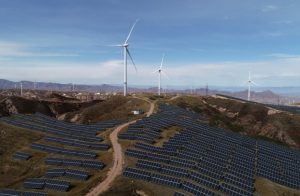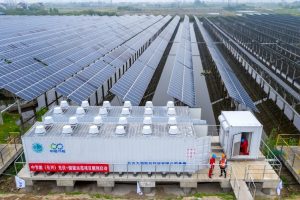Global carbon dioxide (CO2) emissions from the energy sector are on track to peak this year but are still a “long way short” of requirements set out in the Paris Agreement, a new study has warned.
A rapid jump in global adoption of solar power and electric vehicles — led by China — will bring about peak emissions this year, and drive the world to halve its energy emissions by 2050, consultancy DNV said in a study.
But that would also mean the world will fall significantly short of climate goals set out in the Paris Agreement: reducing emissions by 45% by 2030 and reaching net zero by 2050.
Also on AF: BP Dumps Oil Pledge While Chasing Billions in Climate Subsidies
The result would be a global temperature rise of 2.2°C by end of the century, the study warned.
Still, reaching a peak by the end of 2024 would be a significant feat considering energy-related CO2 emissions hit a record high of 37.4 billion tonnes last year. Energy-related emissions account for 70% of the world’s total.
“Emissions peaking is a milestone for humanity. But we must now focus on how quickly emissions decline and use the available tools to accelerate the energy transition,” Group President and CEO of DNV, Remi Eriksen, said in a media release.
Plunging costs of solar and batteries are the leading drivers of emissions reduction as they make way for the removal of coal from the energy mix, while also cutting oil use, DNV said.
Lower prices meant annual solar installations increased 80% last year as it beat coal on cost in many regions, it found.
Global coal consumption in power stations is lower this year than 2023, and India is the only region where power emissions are expected to grow over the next decade, it noted.
Meanwhile, EV sales increased 50% last year and are on track towards a 50% global passenger EV sales share in 2031, the study added. EVs are set to take a 25% share of new passenger vehicles sales globally by next year, it said.
A 14% drop in prices of batteries last year further improved the affordability of solar and EVs. Global average battery prices are on track to nearly halve by 2026 to $80/kWh, according to Goldman Sachs.
The China factor
Surging adoption of solar and EVs was especially pronounced in China, according to the DNV study. “EV uptake is so high that peak gasoline in China is behind us and global peak oil is expected within a couple of years,” it said.
“By 2050, ICE vehicles will scarcely be sold in China.”
China still remains the world’s largest consumer of coal and the biggest emitter of CO2.
The growth of renewables has meant that power-generation from coal has slumped to record low in China this year. Researchers say the data indicates China’s carbon emissions may have peaked last year.
But China will also need to tackle its rising power demand.
A key driver of energy use in China is from commercial buildings and households. As climate change worsens, the country has seen weather fluctuate from record-breaking cold to searing heat.
Increasing heating and cooling needs to manage extreme temperatures will only bump up China’s power demand. It will continue to account for nearly one-fifth of the global buildings energy use, the DNV study said.
Meanwhile, manufacturing has been China’s largest consumer of energy, accounting for over 50% of the country’s total demand in 2022.
But DNV forecasted, that power use will decrease as China’s manufacturing sector electrifies and the demand for steel and cement declines. Still, China’s manufacturing will still use more coal than the rest of the world combined.
Despite those challenges, China remains the frontrunner among middle-income regions in sustaining energy transition policy, the study noted.
The world’s second-biggest economy is backing its decarbonisation with long-term planning, comprehensive supply- and demand-side policy, and supportive measure, it said.
China vs the world
China’s dominant role in the production of clean technologies are also enabling and even speeding up the world’s energy transition, according to the DNV study.
China has, over the years, built nearly-independent supply chains for everything from EVs and solar panels to the very raw materials needed for their production. That has made the country the leading exporter of green technologies and a significant investor in their development overseas.
According to DNV, China accounted for 58% of global solar installations and 63% of new EV purchases in 2023. Its exports of wind turbines and electrolysers needed to produce low-emission hydrogen are also growing.
But that domination has also become a headache for the world, with regions like the United States, Canada, Europe, Southeast Asia and India all raising the alarm on the influx of cheap Chinese products that distort local markets and also pose potential ‘national security concerns’.
That concern has meant that these regions are either imposing steep tariffs on imports of China-made clean technologies, or restricting them all together.
But “diversifying from China too rapidly risks a sharp increase in supply chain and production costs, a duplication of innovation effort, and a slower transition,” the DNV study warned.
“Policymakers must strike a difficult balance between national security, economic goals, and Paris Agreement ambitions,” DNV chief Eriksen said.
‘Natural carbon sinks breaking down’
More troubling news, however, is that scientists fear that the Earth’s natural processes that regulate climate, such as oceans, forests, soils and other carbon sinks, which normally absorb about half of all human emissions, may be breaking down.
In 2023, preliminary findings by an international team of researchers show the amount of carbon absorbed by land has temporarily collapsed and that forest, plants and soil – as a net category – absorbed almost no carbon, according to a report by The Guardian.
It said there were also signs that Greenland’s glaciers and Arctic ice sheets were melting faster than expected, and thus disrupting the Gulf Stream ocean current and slowing the rate at which oceans absorb carbon.
View this post on Instagram
- Vishakha Saxena























